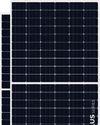
The country has developed a robust and expansive power network spanning various states and connecting islands to the main grids. Today, we have a unified national grid catering to the population's demand. Previously, we operated with segregated microgrids, each functioning independently in four to five regions. However, we unified these microgrids three years ago into a single, cohesive grid system. This integration marked a significant milestone in our power infrastructure development, making us part of a larger, more efficient family of grid operations.
Over the past few decades, our power grid has seen substantial advancements. We continually incorporate smart technologies to reduce harmonics and enhance grid stability. These technologies meet industry standards and have proven effective in supporting and strengthening the grid. As our electricity demand rises daily, we increasingly rely on renewable energy sources, particularly solar power. The low cost of solar energy, ranging from 2 to 4 per unit in different states, has significantly impacted electricity pricing, making it more affordable.
In the near future, we anticipate adding several hydro and other renewable energy projects to our grid. These projects are expected to enhance the grid's robustness, as hydro and thermal sources are particularly effective in maintaining grid stability and reducing harmonics. Integrating these energy sources will make our power supply more reliable and sustainable.
Industry experts share their views on the ongoing modernisation of the transmission and distribution sector, which will ultimately lead to grid resilience.
Expectations in the renewable energy sector
This story is from the August 2024 edition of EPR Magazine (Electrical & Power Review).
Start your 7-day Magzter GOLD free trial to access thousands of curated premium stories, and 9,000+ magazines and newspapers.
Already a subscriber ? Sign In
This story is from the August 2024 edition of EPR Magazine (Electrical & Power Review).
Start your 7-day Magzter GOLD free trial to access thousands of curated premium stories, and 9,000+ magazines and newspapers.
Already a subscriber? Sign In

HIKMICRO AI Acoustic Imager enhances industrial efficiency by detecting air leaks
Industry studies suggest that leaks in compressed air systems can account for up to 30 percent of energy waste. Compressed air leaks are often harder to detect than other types of gas leaks because they do not produce noticeable smells or colours.

Driving innovation and expanding capacity to accelerate India's 2030 renewable energy goal
The company has outlined a strategy to expand its manufacturing capabilities in a phased approach to boost solar panel production to 13 GW. This includes preparation to launch a 4 GW TOPCon cell manufacturing plant by FY 2026-27.

By 2040, 49% of electricity will come from RE
According to the REN21 Renewables 2020 Global Status Report, investments in renewable energy projects and programmes totalled US$64.4 billion between 2014 and 2019.

KUSAM-MECO introduces advanced models 'KM -131D' and 'KM 891'
The KM-131D is an ultrasonic thickness gauge model, while the KM 891 is an auto-ranging true RMS digital multimeter with data logging and a PC interface.

Customisable earthing solutions for smart city safety and sustainability
The firm offers a range of earthing compounds, grounding electrodes, and backfill materials, each tailored to optimise performance for different soil conditions, resistivity levels, and environmental factors. Whether it is a smart grid, renewable energy system, or EV charging station, its solutions can ensure safety, efficiency, and longevity.

Novasys Greenergy pioneering innovation in solar panel manufacturing
The company's mission is to provide reliable, efficient, and affordable solar energy products for both residential and commercial markets.

Make buildings and data centres hubs for energy efficiency
Delta modular UPS (Uninterruptible Power Supply) systems are engineered to help achieve maximum energy efficiency and cut operational costs across residential and commercial requirements.

Smart energy management for sustainable smart cities
Renewable energy, efficient power distribution, and advanced storage technologies are at the heart of smart city initiatives, opening the way for greener, more sustainable urban environments.

Su-Kam is an added layer of resilience against grid failures
Su-Kam offers lithium-ion battery solutions and advanced ESS (Energy Storage Systems) racks, Which enhance energy storage capacity and offer longer life cycles. Its hybrid inverters can operate both off-grid and on-grid, helping to reduce dependence on the national grid.

Advancements in energy storage boosting reliable and clean power solutions
Lithium-ion batteries, with high energy density and declining costs, power everything from EVs to grid storage. Flow batteries offer long-duration storage ideal for balancing renewable sources, while solid-state batteries, though still in development, promise improved safety and lifespan.